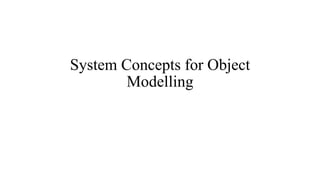
System Concepts for Object Modelling.pptx
- 1. System Concepts for Object Modelling
- 2. Basic Concepts about Object-Orientation •object-orientation is what’s referred to as a programming paradigm. It’s not a language itself but a set of concepts that is supported by many languages. If everything we do in these languages is object-oriented, it means, we are oriented or focused on objects.
- 3. Objects, Attributes, Methods, and Encapsulation •Object-oriented analysis (OOA) is based on several concepts. Some of these concepts require a new way of thinking about systems and the development process. •OOA is concerned with defining the static structure and dynamic behavior models of the information system instead of defining data and process models, which is the goal of traditional development approaches.
- 4. •The object-oriented approach to system development is based on the concept of objects that exist within a system’s environment. Objects are everywhere. An object is a real-world element in an object–oriented environment that may have a physical existence like a customer, a car, etc. or an intangible conceptual existence like a project, a process, etc
- 5. •object is something that is or is capable of being seen, touched, or otherwise sensed and about which users store data and associate behavior. •In object-oriented circles, an attribute is the data that represents characteristics of interest about an object Figure 1. Object, State and Behavior (Source: Charlie-Anne's Gaming Blog (:)
- 6. • In object-oriented circles, an object’s behavior is commonly referred to as a method, operation, or service. Object-oriented approaches to systems development simply requires an adjustment to how we commonly perceive objects. • Another important object-oriented principle is that an object is solely responsible for carrying out any functions or behaviors that act on its own data (or attributes). • This leads us to an important concept in understanding objects: encapsulation. Encapsulation is the packaging of several items together into one unit. Applied to an object, both attributes and behavior of the object are packaged together. They are considered part of that object. The only way to access or change an object’s attributes is through that object’s specific behaviors.
- 7. Classes, Generalization, and Specialization •Object class is a set of object instances that share the same attributes and behaviors; often referred to simply as a class. For example, it would be natural for you to classify both your Systems Analysis and Design Methods textbook and another textbook, such as Introduction to Programming, as a BOOK. Both these object instances have some similar attributes and behavior. For example, similar attributes might be ISBN NUMBER, TITLE, COPYRIGHT DATE, EDITION, and so on. Likewise, they have similar behavior, such as being able to OPEN and CLOSE. There may be several other objects within your environment that could be classified because of their similarities.
- 8. •We can also recognize subclasses of objects. For example, some of the individuals in the room might be classified as STUDENTS and others as TEACHERS. Thus, STUDENT and TEACHER object classes are members of the object class PERSON •Inheritance is the concept wherein methods and/or attributes defined in an object class can be inherited or reused by another object class Figure 2. Example of Subclasses of Objects (Source: System Analysis and Design Methods)
- 9. • Generalization/Specialization, sometimes abbreviated as gen/spec, is a technique wherein the attributes and behaviors that are common to several types of object classes are grouped (or abstracted) into their own class, called a supertype. The attributes and methods of the supertype object class are then inherited by those object classes known as subtypes.
- 10. • the object classes STUDENT and TEACHER contain attributes and behaviors which are unique to them (making them more specialized) but that they also have access to the generalized attributes and behaviors of the PERSON object class via inheritance. Figure 3. Supertype and Subtype Relationships between Object Classes (Source: System Analysis and Design Methods)
- 11. •The object class PERSON is referred to as a supertype (or generalization class). A supertype is an entity that contains attributes and behaviors that are common to one or more class subtypes. It is also referred to as abstract or parent class. The object classes STUDENT and TEACHER are referred to as subtypes (or specialization classes). A subtype is an object class that inherits attributes and behaviors from a supertype class and then may contain other attributes and behaviors that are unique to it. It is also referred to as child class and, if it exists at the lowest level of the inheritance hierarchy, it is referred as concrete class.
- 12. illustrates how to depict the supertype-subtype relationship between the PERSON, STUDENT, and TEACHER object classes using UML notation. All the attributes and behaviors of the PERSON object class are inherited by the STUDENT and TEACHER object classes. The attributes and behaviors that uniquely apply to a STUDENT or TEACHER are recorded directly in the subtype class symbol (Whitten & Bentley, 2005).
- 13. Figure 4. Representing a Generalization/Specialization Relationship Using the UML
Editor's Notes
- For example, an object “Person” can be described according to some common attributes such as LAST NAME, SOCIAL SECURITY NUMBER, PHONE NUMBER, and ADDRESS. And each person represents an instance of a “Person” object. An object instance is each specific person, place, thing, or event, as well as the values for the attributes of that object.
- For example, only YOU (an object) may CHANGE (behavior) your LAST NAME and HOME ADDRESS (attributes about you).